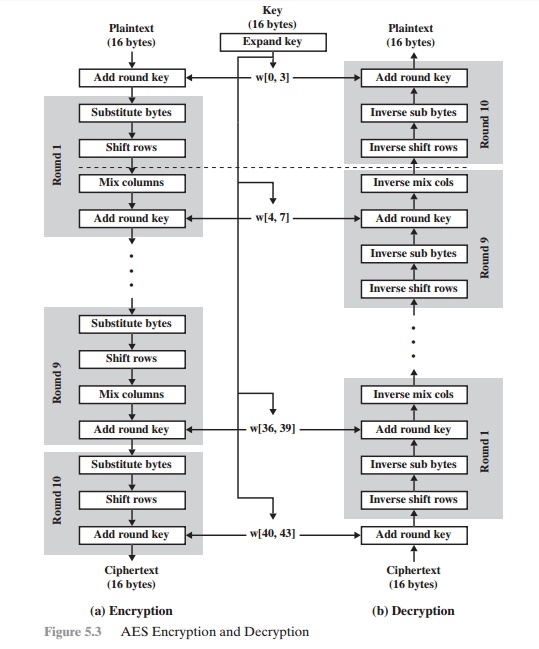Chapter: Cryptography and Network Security Principles and Practice : One Symmetric Ciphers : Advanced Encryption Standard
AES(Advanced Encryption Standard) Structure
AES STRUCTURE
General Structure
Figure 5.1 shows the overall structure of
the AES encryption process. The cipher takes
a plaintext block
size of 128
bits, or 16 bytes.
The key length can
be 16, 24,
or 32 bytes (128,
192, or 256 bits). The algorithm is referred to as AES-128,
AES-192, or AES-256, depending on the key length.
The input to the
encryption and decryption algorithms is a single 128-bit
block. In FIPS PUB 197, this block is depicted as a 4 * 4 square matrix of bytes.
This block is copied into
the State array, which is modified at each stage
of encryption or decryp-
tion. After the final stage, State is copied to an output matrix. These operations are depicted in Figure 5.2a.
Similarly, the
key is depicted as a square
matrix of bytes. This
key is then expanded into an array of key schedule words. Figure 5.2b
shows the expansion for the 128-bit key. Each word is four bytes, and the total
key schedule is 44
words for the 128-bit key. Note that the ordering of bytes within
a matrix is by col- umn. So, for example, the first four bytes of a 128-bit
plaintext input to the encryption cipher occupy the first column
of the in matrix, the second four
bytes occupy the second column, and so on. Similarly, the first four bytes of the expanded
key, which form a word,
occupy the first
column of the w matrix.
The cipher consists
of N rounds, where the number of rounds depends
on the key length:
10 rounds for a 16-byte
key, 12 rounds for a 24-byte
key, and 14 rounds for a 32-byte key (Table 5.1). The first N - 1 rounds consist of
four distinct trans- formation functions: SubBytes, ShiftRows, MixColumns, and
AddRoundKey, which are
described subsequently. The final round contains only three transformations,
and there is a initial single transformation (AddRoundKey) before the first round,

which can be considered Round 0. Each
transformation takes one or more 4 * 4
matrices as input and produces a 4 * 4
matrix as output. Figure 5.1 shows that the output of each round is a 4 * 4 matrix, with the output of the final round being the
ciphertext. Also, the key expansion function generates N + 1 round keys, each of which is a distinct 4 * 4 matrix. Each round key serve as one of the inputs to the
AddRoundKey transformation in each round.


Detailed Structure
Figure 5.3 shows
the AES cipher
in more detail,
indicating the sequence
of transfor- mations in each round and showing
the corresponding decryption function. As was done in Chapter 3, we show encryption
proceeding down the page and decryption proceeding up the page.
Before delving into details, we can make several comments about the overall
AES structure.
1.
One noteworthy feature of this
structure is that it is not a Feistel structure. Recall that, in the classic
Feistel structure, half of the data block is used to modify the other half of the data block and then the halves are swapped.
AES instead processes the entire data block as a single matrix during
each round using substitutions and permutation.
2.
The key
that is provided as input is expanded into an array of forty-four 32-bit words,
w[i]. Four distinct words (128 bits) serve as a round key for each round;
these are indicated in Figure 5.3.
3.
Four different stages are used,
one of permutation and three of substitution:
•
Substitute bytes: Uses an S-box to perform a byte-by-byte substitution of the block
•
ShiftRows: A simple permutation
•
MixColumns: A substitution that makes
use of arithmetic over GF(28)
•
AddRoundKey: A simple bitwise XOR of the current block with a portion
of the expanded key
4.
The structure
is quite simple. For both encryption
and decryption, the cipher begins with an AddRoundKey stage, followed by nine rounds
that each includes
all four stages, followed
by a tenth round of three stages.
Figure 5.4 depicts the structure of a full encryption round.
5.
Only the AddRoundKey stage makes use of the key. For this reason,
the cipher begins and ends with an AddRoundKey stage. Any other stage, applied
at the beginning or end, is reversible without knowledge of the key and so would add no
security.
6.
The AddRoundKey stage is, in effect, a form of Vernam cipher and by itself would not be
formidable. The other three stages
together provide confusion, diffusion, and nonlinearity, but by themselves would provide no security
because they do not use
the key.We can view the
cipher as alternating operations of XOR

encryption (AddRoundKey) of a block,
followed by scrambling of the block (the
other three stages),
followed by XOR encryption, and so on. This scheme
is both efficient and highly secure.
7.
Each stage is easily reversible. For the Substitute Byte, ShiftRows, and MixColumns stages, an inverse
function is used in the decryption algorithm. For the AddRoundKey stage, the inverse
is achieved by XORing the same round key to the block, using the result that
A Ⓧ B Ⓧ B = A.
8.
As with most block ciphers, the decryption
algorithm makes use of the expanded key in reverse order.
However, the decryption
algorithm is not

identical to the encryption algorithm. This is a consequence of the
particular structure of AES.
9.
Once
it is established that all four stages are reversible, it is easy to verify that
decryption does recover the plaintext.
Figure 5.3 lays out encryption and decryption going in opposite vertical directions. At each horizontal point (e.g., the dashed line in the figure), State is
the same for both encryption and decryption.
10.
The final
round of both encryption and decryption
consists of only three stages. Again, this is a consequence
of the particular structure of AES and is required to make the cipher reversible.
Related Topics